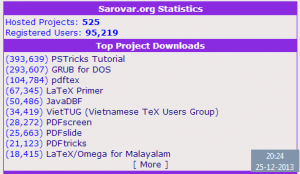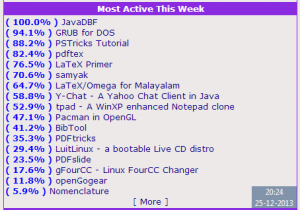JavaDBF Found a New Home as Sarovar.org Shuts Down
by anil on December 26, 2013
I wrote JavaDBF library back in 2003 as no Free/Open Source library was available to read/write XBase file formats in Java. That period was the fag end of XBase’s glory days. Many legacy data were available in that format which need to be fetched/migrated/exported to RDBMS-based system or to spreadsheet formats. Since its first version, JavaDBF has been used in a variety of applications ranging from personal projects to business systems to embedded systems. It has been ported to .Net by independent contributors and thus made it available in native Microsoft platform as well. A version that works in Android too is available now. However, one of the applications that fascinated me most was from the agro/farm domain:
We’re using JavaDBF to make it easier to read data coming from certain sensors that are used in tractors. They measure lots of values which can be read as a dbf file that contains those values together with GPS coordinates which we use to project on a map.
When I ran a check on the net recently, I found many “unauthorized” (claiming to be the original version) forks spread across the Web and that too with donation buttons! That’s how Free/Open Source works 🙂
JavaDBF which was released in GNU/LGPL license had been available for download at Sarovar.org ever since. It crossed 50,000 downloads so far and still counting.  Unfortunately, Sarovar.org–India’s first and probably last Free/Open Source hosting website–is shutting down this December 31 (2013). See the details here: http://sarovar.org/forum/forum.php?forum_id=1899 (link will be available till the shutdown).
Unfortunately, Sarovar.org–India’s first and probably last Free/Open Source hosting website–is shutting down this December 31 (2013). See the details here: http://sarovar.org/forum/forum.php?forum_id=1899 (link will be available till the shutdown).
So JavaDBF that still continues to be popular had to find a new home and it finally moved into Google Code.  It will be available at the URL: http://code.google.com/p/javadbf/ here onwards. Google Code is no match for Sarovar.org considering the facilities such as project web site, forums and mail lists which were available at Sarovar.org. But I have decided to opt for Google Code instead of other available options.
It will be available at the URL: http://code.google.com/p/javadbf/ here onwards. Google Code is no match for Sarovar.org considering the facilities such as project web site, forums and mail lists which were available at Sarovar.org. But I have decided to opt for Google Code instead of other available options.
Indian Free/Open Source history will not be complete without the story of Sarovar.org which was solely funded by River Valley Technologies and maintained by the folks at Linuxense/Mettle Networks for the past 10+ years. Thanks to all those who made it run this far.
Good bye, Sarovar.org!
New link for JavaDBF: http://code.google.com/p/javadbf/
How I Explained Cloud Computing to My Mom
by anil on August 9, 2013
“Clouds come floating into my life, no longer to carry rain or usher storm, but to add color to my sunset sky.”
— Rabindranath Tagore, Stray Birds
Cloud: A Jargon in the Market with a Redefined Meaning
It has been one of the most misunderstood, misused technology terms in the past few years by customers, vendors and technical staff alike. It means different things to different people. There is nothing wrong in that per se. But they think that is what it is all about.  Vendors feel they are not up-to-date without that term included in their brochure. Me too was confused–confused because of the way people use it. Especially when you are expected to respond to such wrong references in delicate situations such as in a CXO meeting. Many times I witnessed people getting frustrated out of the confusion caused by the misuse of the term. This forced me to make an attempt explaining Cloud Computing in a technically correct way.
Vendors feel they are not up-to-date without that term included in their brochure. Me too was confused–confused because of the way people use it. Especially when you are expected to respond to such wrong references in delicate situations such as in a CXO meeting. Many times I witnessed people getting frustrated out of the confusion caused by the misuse of the term. This forced me to make an attempt explaining Cloud Computing in a technically correct way.
The Term “Cloud” and the Concept is Not New in Computing
The term “cloud” has been used in the IT field for quite long. It is used when something is to be represented in terms of functionality yet internals are not of interest to the current context, or internals to be kept hidden deliberately, or to simply abstract complexity. For example “Internet Cloud” bubble is used in diagrams where primary interest is in the LAN. An “MPLS Cloud” bubble is used in diagrams when an Extranet is explained with the magical [MPLS] VPN links criss-crossing various locations. Here is the dictionary meaning of Cloud and it is evident why it makes a good metaphor:
Cloud [kloud]: “A dim or obscure area in something otherwise clear or transparent.”
So “Internet Cloud” makes the Internet so simple: No access network, no back haul, no peering, no routing, no submarine cable, no nothing–when you ping server at the other end of the world, bingo!, you get a ping echo; Cloud makes Internet things simple! Every time when we want to abstract a complex service or an infrastructure, we make it a Cloud.
We also attribute no limitation to its capability or scale. Internet cloud is large enough for anything we plan, VPN cloud is broad enough to carry our communication needs and so on. Or in a more technically correct way we expect that provider to expand, scale and function as we expect.
What Cloud Means to the Engineering Team
Hosted services are generally called Cloud Services these days. Setting up a new service, in a Cloud-based approach, is a matter of operational understanding of service offering and getting an SLA negotiated. Rest assured, supposedly. You get that service over the Internet/network, mostly accessed by a web browser. That also means, the internal technical team does not have to worry about evaluating infrastructure components, and more painful aspect of running it meeting required service levels.
In addition to this, internal team does not need to know how such a service functions internally, rather they just need to know how to monitor it, ensuring SLA compliance.
Cloud-based infrastructure scales to meet your need–in terms of storage capacity, CPU power, or network bandwidth. This helps to avoid the otherwise-inevitable job of acquiring and provisioning new additions to the infrastructure.
What Cloud Means to the CFO
It is a common trend across industry verticals to cut down cost and upfront capital investments. Cloud offerings fall in line with this practice by help converting capital expenses to operational expenses. Cloud offerings, in general, work out to be cheaper overall as the resources are often shared well across multiple users and organizations. And you pay only for what you use.
Another advantage is that a cloud-based service is ready-to-use compared to the time taken to set up an infrastructure until start running a service. Look at a simple email service like Gmail and see how easy to sign up and have an email ID! This is similar to a cloud service sign up (in fact, it is a cloud-based service, going by the definition). Alternative to this approach is to buy a server hardware, install email services software in it, lease an Internet connection, sign up for DNS service and provision your first email ID. That is the CAPEX model.
You save a lot on running and maintenance cost as well; not just in CAPEX. Saving on electricity, administrator salaries, system security expenses, software license fee, etc. can be significant in many cases.
In addition to all the above, there is an interesting benefit which exceeds them all in the eyes of a CFO; that is the ability of the Cloud to support fluctuating and unpredictable demands for in incremental fee. Most provides offer practically unlimited capacity expansion and sometimes without any long term contract. This is a boon to businesses especially in times of difficulty.
Is Cloud Computing the Best thing After Sliced Bread?
Cloud is not an answer for all your needs. Most of the time Cloud is an option. But there are occasions where running your own infrastructure will prove to be better. A bank may not host their banking systems in a third-party Cloud for obvious reasons; security and massive round-the-clock resource demands justifies to have their own set up. But you can run a enterprise CRM or a ERP off the Cloud and it makes a lot of sense.
Is the cloud cleared now? Have a great day!